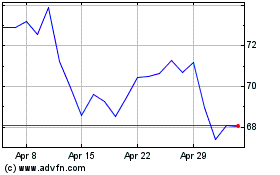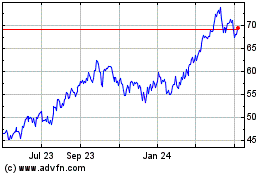CORRECT: Imperial Oil, Exxon To Pursue New Routes For Oil-Sands Equipment
August 08 2011 - 5:14PM
Dow Jones News
After encountering legal challenges to their plan to move giant
loads of oil-sands equipment through Idaho and Montana, Imperial
Oil Ltd. (IMO) and Exxon Mobil Corp. (XOM) said Monday they will
break down the loads into smaller pieces and pursue other routes,
at a great expense.
Many of the 205 pieces of large oil-sands equipment built in
South Korea were destined to travel through Idaho and Montana on
two-lane U.S. Highway 12, with Imperial planning to widen the road
in some cases to make room for the giant pieces of equipment on the
scenic highway through Montana's Lolo pass.
Imperial, 70% owned by Exxon Mobil, wanted to use the
low-traffic scenic route to ship oversized loads larger than two
lanes of traffic and several times longer than the average semi
trailer, by moving the modules very slowly at night and pulling
over every few miles to let any traffic pass.
But the company faces legal challenges in both states claiming
that Imperial's plan would potentially damage tourism revenues, the
local highways and environment.
After facing months of permitting delays and legal obstacles,
Calgary-based Imperial Oil now says it will to break up the
equipment into smaller pieces so it can be transported in semi
trucks on interstate highways in Washington State, Idaho and
Montana--or face a delay of the $11 billion Kearl oil-sands
project, which is scheduled to begin operations by the end of next
year.
Each of about 150 oversized modules will cost about $500,000 to
disassemble and reassemble after a roughly 1,300-mile journey from
the port of Vancouver, Wash., to Kearl Lake, Alberta.
It also amounts to about 5,000 to 6,000 hours of skilled labor
by technicians per module, Imperial Oil spokesman Pius Rolheiser
said.
"They were not intended originally to be disassembled into
smaller loads," Rolhieser said, "So it's significant, not only the
cost but as a technical challenge."
However, Rolhieser said the extra cost will not raise the budget
of the project. He said the permitting delays will make meeting the
schedule to begin production next year "more challenging," though
he added the project is still on track to meet that timeline.
The first phase of the Kearl project is expected to produce
110,000 barrels of oil a day from the 4.6-billion-barrel reserve in
northern Alberta. Subsequent phases would bring the project up to
345,000 barrels a day.
Rolhieser said that Imperial is still pursuing permits to allow
it to move the larger pieces of equipment through Montana and
Idaho.
Shares of Imperial Oil closed down 4.6% Monday at $38.35 on the
New York Stock Exchange amid a broader pullback in oil and gas
equities.
-By Edward Welsch, Dow Jones Newswires; 403-229-9095;
edward.welsch@dowjones.com
Imperial Oil (AMEX:IMO)
Historical Stock Chart
From Jun 2024 to Jul 2024

Imperial Oil (AMEX:IMO)
Historical Stock Chart
From Jul 2023 to Jul 2024
